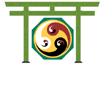
A Book of Little Traditions

|
minzoku NEO-shintô A Book of Little Traditions |
|
|
ToC |
||
|
shu (Amulets & Protective Items) – 08 / 26 / 2014
(guard, protect, defend, obey)
❖ Amulets and protective items omamori – Personal protective charms
jufu – Written spells
do (soil, earth)
rei (smalll bell) dorei (earthenware/ceramic bell) ❖ Small bells used to pray for good fortune, frequently in the shape of the animal representative of the astrological calendar
e (picture, drawing, painting, sketch)
ma (horse) ema (votive picture – originally of horse) ❖ Small wooden plaques that wishes or desires are written upon and left at a place in the shrine grounds so that one may have a wish or desire fulfilled
ha (rend, rip, tear, break, destroy, defeat, frustrate)
ma (witch, demon, evil spirit) ya (dart, arrow) ❖ Demon-breaking arrow ❖ A symbolic arrow for the fight against evil and bad luck
ha (rend, rip, tear, break, destroy, defeat, frustrate)
ma (witch, demon, evil spirit) yumi (bow) ❖ Demon-breaking bow ❖ Ceremonial bow used with hamaya to drive off evil
ino.ri (pray, wish, supplication)
❖ Prayers to the kami written on pieces of paper that help students pass examinations or sick people recover from an illness ❖ Also called o-inori ❖ Or oinori
o (honorable)
ino.ri (pray, wish, supplication)
inu (dog)
ha.ri (lengthen, stretch, spread) ko (child) ❖ A paper doll of a dog used to bless and provide a good birth
kado (gate)
nyû (enter) dô (road-way, street, teachings) nyûdô (priest, monk, shaved head) – Buddhist term ❖ A pair of standing logs with carved faces, that flank an entrance and act as a talisman against evil spirits
maga (bent, curve, crooked)
tama (ball, jewel) ❖ Curved beads ❖ An ancient shintô talisman of good fortune
mane.ki (beckon, invite, summon)
neko (cat) ❖ (Literally "beckoning cat") ❖ One of the most common lucky charms in Japan, designed to attract business and promote prosperity ❖ Found frequently in shop windows, the maneki neko sits with its paw raised and bent, beckoning customers to enter ❖ Also called welcoming cat, lucky cat, money cat, fortune cat
o.ki (to get up)
a.gari (arise) ko- (little, small) bo | ho (method, law, rule, principle, model, system) shi (expert, teacher, master) ❖ Getting up little preist ❖ A papier-mache doll designed so that its weight causes it to return to an upright position if it is knocked over ❖ It is considered a good-luck charm and a symbol of perseverance and resilience
❖ An okiagari doll modeled after Bodhidharma
❖ These dolls are typically red and depict a bearded man (Dharma), they vary in color and design ❖ daruma is regarded as a talisman of good luck
shin | kami (that which inspires feelings of reverence, awe, gratitude, fear/terror)
pu | fu (token, sign, mark, tally, charm) ❖ (amulet, charm)
shin | kami (that which inspires feelings of reverence, awe, gratitude, fear/terror)
satsu (tag, placard) ❖ (protective amulets sold at shintô shrines) |
|||||||||||||||||||||||||||||||||||||||||||||||
|
|